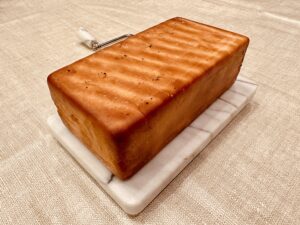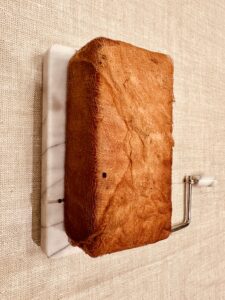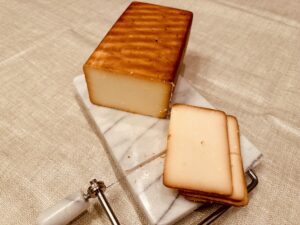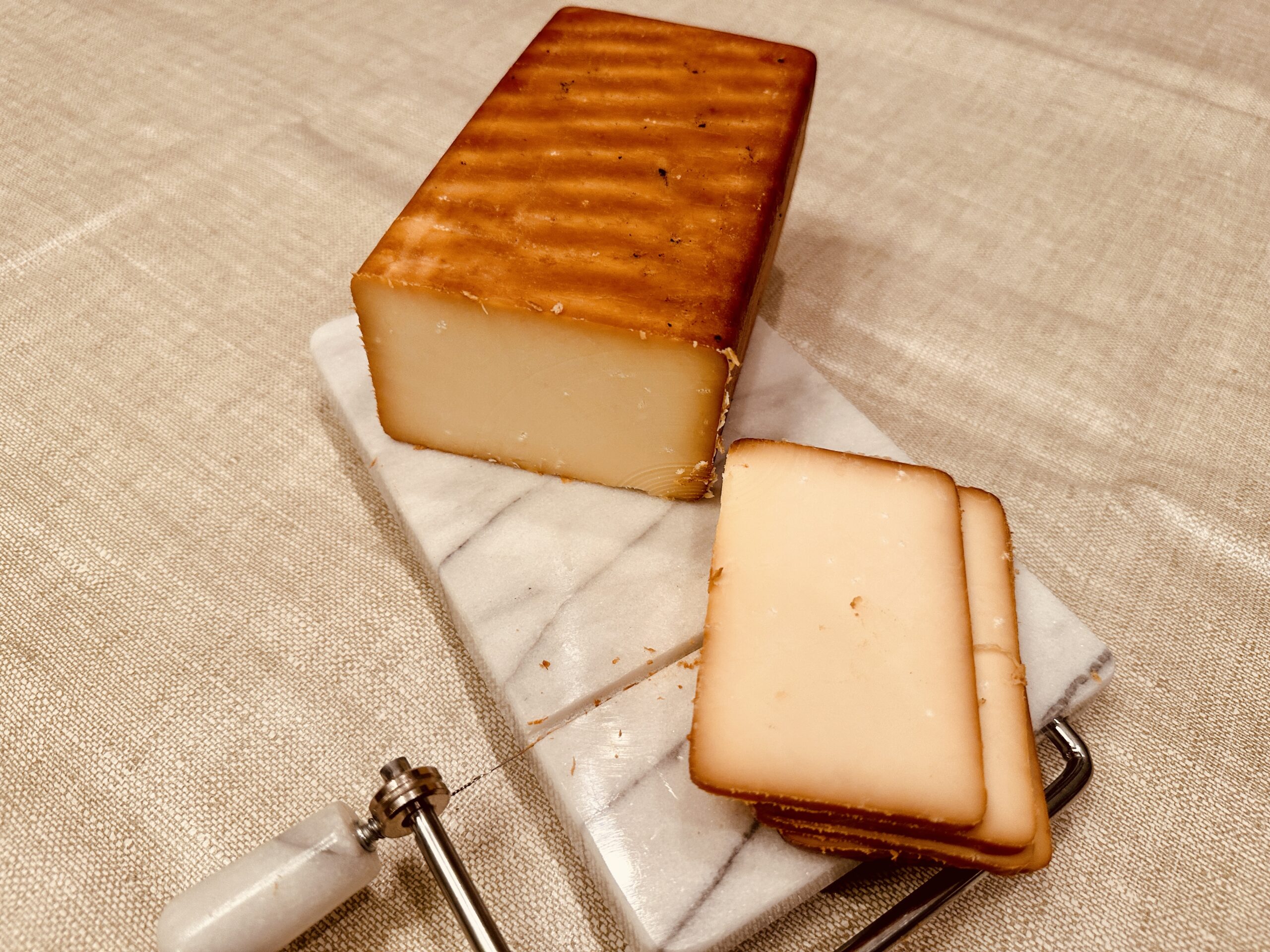
As a kid, I used to love going to the Hickory Farms store in the mall for free samples of their smoked cheese. I loved the color and taste. Then Hickory Farms disappeared for a long time, only popping up occasionally right before Christmas. Maybe my tastes have changed, or (more likely) their process has changed, but it’s not as good as I remember. So I make my own!
Table of Contents
The Origins and History of Making and Smoking Cheese
The origins of cheese making, and smoked cheese, date back to ancient times. It is likely that cheese was first made by accident when milk was stored in a container made from an animal’s stomach. The rennet in the stomach would have caused the milk to curdle, forming the first cheese. The exact date when people first started making cheese is difficult to determine, but it is likely that cheese making has been around for at least 4,000 years. The ancient Egyptians, Greeks, and Romans all made cheese, and it has been an important food for people around the world for centuries.
Cheese melts at warm temps, so you have to cold smoke it. Cold smoking is a method of preserving food in which the food is exposed to smoke at a low temperature, typically between 86 to 140 degrees Fahrenheit (30 and 60 degrees Celsius). This is done to add flavor to the food without cooking it and is often used for meats and fish. The food is placed in a smokehouse or other enclosed area, where it is exposed to smoke from a smoldering fire made of wood chips or other fuel. This process can take several days to a week, depending on the type of food and the desired level of smoke flavor. Cold smoking can also be used to add smoke flavor and color to cheese, and we’re going to share with you just how we do it!
Smoking cheese was a way to make it last longer, especially in the days before refrigeration. Over time, the practice of smoking cheese evolved, and it became a way to add flavor to the cheese, rather than just a way to preserve it. Today, smoked cheese is enjoyed around the world and is used in a variety of dishes.
Legends of the Cheese
There are many legends and stories about cheese in different cultures all around the world:
- In Greek mythology, it is said that the goddess Athena gave the art of cheese making to the people of Greece.
- Robin Hood, the outlaw is said to have stolen cheese from the rich to give to the poor.
- In the Middle Ages, cheese was thought to have magical properties, and was sometimes used in spells and potions.
- British legend of King Arthur, a giant named Cormoran is said to have been defeated by King Arthur and his knights, who tricked him into eating a huge amount of cheese, causing him to become so bloated that he could not move.
- In the French legend of “The Cowherd and the Weaver,” a poor cowherd is rewarded with a magical cheese that never runs out.
- In the Swiss legend of William Tell, the hero is said to have used a piece of cheese to help him shoot an apple off his son’s head.
- In the Italian legend of the Witch of Verona, a witch named Catharina is said to have been defeated by a group of villagers who used cheese to lure her into a trap.
- In the Irish legend of St. Patrick, the saint is said to have banished all the snakes from Ireland by tossing a wheel of cheese into the sea, where the snakes followed it and drowned.
- Maybe not, but who’s to say for sure?
Trappist Monks and Cheese
Trappist Monks and Cheese
During a tour of Belgium with my Dad and brother, we visited all 6 Belgian Trappist abbey’s that were brewing beer. Many also make cheese. The cheesey highlight of the trip was easily the “old cheese” (aged) at Orval. We devoured wedge (probably about a pound) while walking through the ruins of the old abbey.
Trappist monks have a long history of making cheese. Trappist monasteries are known for their traditional methods of cheese making, which involve using natural ingredients and time-honored techniques to produce high-quality cheese. The monks follow strict guidelines to ensure the quality of their cheese, and the production of Trappist cheese is closely regulated by the International Trappist Association.
The Trappist monks first began making cheese as a way to support themselves and their monasteries. The cheese they produced was sold to the local community, and the proceeds were used to support the monastery and its charitable works. Over time, the monks’ cheese making skills improved, and they began to produce a wide range of high-quality cheeses.
Today, Trappist monks continue to produce cheese using traditional methods. The cheese is made from the milk of cows, goats, or sheep that are raised on the monastery’s land. The cheese is aged for several months in the monastery’s cellars, where it develops its distinctive flavor and texture. The monks use natural ingredients and do not add any artificial preservatives or flavors to the cheese.
Trappist cheese is known for its high quality and unique flavor. It is often enjoyed on its own, or used in a variety of dishes. The proceeds from the sale of Trappist cheese are used to support the monastery and its charitable works, making it not only a delicious food, but also a product with a noble purpose.
Cheesey Fact: The most expensive cheese in the world is reportedly a variety called Pule, which is made from the milk of Balkan donkeys. Pule is produced in Serbia and is known for its unique flavor and rarity. It takes roughly 6 ½ gallons of mile to create 2 lbs of this cheese! A single pound of Pule can cost up to $600, making it one of the most expensive cheeses in the world. Other expensive cheeses include a Swiss cheese called Vacherin Mont d’Or, which can cost up to $300 per pound, and an Italian cheese called Caciocavallo Podolico, which can cost up to $200 per pound.
Cheese Styles for Smoking
In addition to cheese makers and home cooks, there are also professional smokehouses that specialize in smoking cheese and other foods. These smokehouses use specialized equipment and techniques to smoke cheese and may offer a variety of smoked cheese products for sale. Some cheese makers also operate their own smokehouses, where they smoke their own cheese using traditional methods. Smoking cheese is a time-honored tradition that is enjoyed by many people around the world and is a great way to add flavor and complexity to this popular food.
The best cheeses for smoking are hard, semi-hard, or semi-soft cheeses that have a high moisture content. These cheeses will absorb the smoky flavor well and will also hold their shape during the smoking process. Some of the best cheeses for smoking include cheddar, gouda, mozzarella, and feta. These cheeses are all flavorful and versatile and will take on the smoky flavor well.
Cheese can be made from a variety of different types of milk, including cow’s milk, goat’s milk, and sheep’s milk. Cow’s milk is the most commonly used type of milk for making cheese, and is the base for many popular cheeses, such as cheddar, mozzarella, and gouda. Goat’s milk is also commonly used to make cheese, and is the base for many types of goat cheese. Sheep’s milk is less commonly used to make cheese, but is the base for many types of sheep’s milk cheese, such as feta and ricotta. Cheese can also be made from the milk of other animals, such as buffalo and camel. The type of milk used to make cheese will affect its flavor and texture, so different types of milk are used to make different types of cheese.
Hard cheese is made by allowing the curds to drain for a longer period of time, which results in a drier, harder cheese. Soft cheese, on the other hand, is made by allowing the curds to drain for a shorter period of time, which results in a moister, softer cheese. Hard cheese is typically aged for longer periods of time, which gives it a stronger flavor, while soft cheese is often consumed fresh and has a milder flavor. There are many different types of hard and soft cheeses, and the specific characteristics of each type will vary.
Some popular hard cheeses include cheddar, parmesan, gouda, and manchego. Cheddar is a type of hard cheese that is made from cow’s milk and has a sharp, tangy flavor. Parmesan is a hard cheese that is made from cow’s milk and has a nutty, salty flavor. Manchego is a Spanish cheese that is made from sheep’s milk and has a tangy, slightly nutty flavor. Authentic Gouda is a Dutch cheese that is made from cow’s milk and has a rich, slightly sweet flavor. It’s very similar in texture to parmesan, but most of what you see labeled “gouda” in the store is a processed cheese. This is not a bad thing, just different. Processed gouda cheese tends to be much softer than the real deal, but is excellent for smoking!
Some popular soft cheeses include brie, camembert, feta, and ricotta. Brie is a soft cheese that is made from cow’s milk and has a creamy, slightly tangy flavor. Camembert is a French cheese that is similar to brie and has a creamy, earthy flavor. Feta is a Greek cheese that is made from sheep’s milk and has a tangy, salty flavor. These are just a few examples of the many different types of soft cheese that are available.
You can also try smoking other types of cheese, such as cheddar, feta, or brie, to see how they take to the smoking process. It’s fun to experiment with other types of cheese to see how they turn out when smoked. I’ve had some good results with blue cheeses, and our friend Big L smokes Cooper Sharp that comes out incredible!
Most of the cheese you find in the dairy case of the grocery store, like gouda, are processed cheeses. Processed cheese is made by combining several different types of cheese and mixing them with emulsifiers, preservatives, and other ingredients. This creates a cheese product that is smooth, uniform in texture, and has a longer shelf life than natural cheese. Natural cheese, on the other hand, is made by allowing milk to curdle and form cheese, without the addition of any extra ingredients.
Natural cheese is more variable in texture and flavor and has a shorter shelf life than processed cheese. Processed cheese is often less expensive and more convenient than natural cheese, but it does not have the same flavor and texture as natural cheese. If you’re putting together a charcutier board, natural cheese is the way to go. But for intense smoke flavor, processed cheese is easier to work with and will usually absorb better and produce better results.
Smoking cream cheese has been a recent trend. Smoked cream cheese works great in dips and spreads. It’s thick enough to hold its form, yet soft enough to mix easily with other ingredients… say bacon and jalapenos? If your using it right away, you can straight up grill or BBQ the cream cheese, but if you’re using it later it will hold it’s shape better under cold smoke.
Let’s Get Smoking


The cheese should be smoked at a low temperature for several hours. This will give the cheese a rich smoky flavor and a gorgeous golden-brown color. Colder is better but try to stay under 120 degrees Fahrenheit. You can experiment with different types of wood chips to give the cheese different flavors. Apple is commonly seen in the grocery store, but we’ve had really outstanding results with a blend of Traeger-type hardwood pellets and a mix of cherry and pecan wood chips. Super intense flavors like mesquite or hickory should be used sparingly if at all. I love mesquite BBQ chicken or hickory smoked [enter any meat here], but it comes off a bit harsh in cheese.
To smoke cheese, you will need a smoker or a grill that can be used for smoking. First, prepare your grill or smoker by lighting a fire using wood chips or other fuel. Wrapping the cheese in cheesecloth is recommended, but not required. Cheesecloth will help the cheese absorb the color and flavor of the smoke and a quick spritz of water helps things to work better. Once the fire is smoldering, place the cheese (preferably wrapped in the cheesecloth) on a rack, in a smoker box, or place a cold smoking tube in the smoker. After about 4 hours, your smoker tube is probably burned out. If you like intense smoke, fill the tube up for round two! Otherwise, you’re cheese is smoked, but needs some time to mellow. Remove the cheesecloth and package. Give the cheese about 2 weeks to rest and mellow out, and you’ll have an amazing tasting home smoked cheese!
Who Cut the Cheese???


The best way to slice cheese will depend on the type of cheese that you are slicing and the desired thickness of the slices. A wire works best in most situations. In general, it is best to use a sharp knife to slice cheese, as a dull knife will compress the cheese and make it difficult to cut cleanly. For hard cheeses, such as cheddar or gouda, it is best to use a cheese wire or a sharp knife to slice the cheese into thin, even slices. For softer cheeses, such as brie or camembert, a knife with a rounded tip can be used to cut the cheese into wedges or slices. You can also use a cheese slicer or a mandolin to slice cheese evenly and to achieve the desired thickness.
Cheese Smoking Safety & Storage
Smoking cheese is a technique that is used by cheese makers and home cooks alike. Cheese makers may smoke cheese as part of the cheesemaking process, to add flavor and color to the finished product. Home cooks may smoke cheese as a way to add flavor to their dishes, or as a way to preserve the cheese for longer periods of time. Smoking cheese is a traditional method of food preservation that has been used for centuries and is still popular today.
Smoking cheese is generally considered to be safe, as long as it is done properly. However, there are a few potential risks to be aware of. One risk is that the cheese could become contaminated with bacteria if it is not stored properly after it has been smoked. It is important to keep the cheese refrigerated or to use it within a few days of smoking it to avoid any potential contamination. Properly packaged and refrigerated, I’ve had cheese I smoked last for 6 months! You’re more likely to have to deal with mold than bacteria.
If smoked cheese has become contaminated with bacteria, it will often have a bad smell and an off-flavor. It may also appear slimy or discolored. If you are unsure whether smoked cheese is safe to eat, it is always best to err on the side of caution and discard it. It is also important to handle and store smoked cheese properly to avoid contamination in the first place.
The best way to store cheese depends on the type of cheese and how quickly you plan to use it. In general, it is best to store cheese in the refrigerator, where it will stay fresh for longer. Hard cheeses, such as cheddar or gouda, can be wrapped in wax paper or aluminum foil and stored in the refrigerator for up to several weeks. Soft cheeses, such as brie or camembert, should be stored in their original packaging or in a container with a tight-fitting lid. Vacuum packed cheese can last several months. Cheese can also be frozen, but this will change its texture and flavor, so it is best to only freeze cheese if you plan to use it for cooking.
Cheese and Beer Pairings
The best cheese and beer pairings will vary depending on personal taste, but some general guidelines can be followed to help you choose a good combination. In general, light-flavored, hoppy beers pair well with mild, creamy cheeses, such as brie or camembert. Stronger, more flavorful beers, such as stouts or porters, pair well with stronger-flavored cheeses, such as cheddar or gouda. Aged, nutty cheeses, such as parmesan or gorgonzola, pair well with malty beers, such as amber ales or brown ales. Experimenting with different combinations is the best way to find the perfect cheese and beer pairing for your personal taste. When it doubt, stilton blue cheese and almost any beer are otherworldly!
Cheese on the Side
Smoked cheese can be served with a variety of dishes and can be used in a variety of ways in cooking. Some common dishes that are served with smoked cheese include salads, sandwiches, and grilled dishes. Smoked cheese can also be added to soups, casseroles, and other dishes to add flavor. It can be served as part of a cheese platter, along with other types of cheese, fruits, and crackers. You can also serve smoked cheese on its own as a snack, either on its own or with crackers or bread. The possibilities are endless, so feel free to experiment and see what you like best. Maybe a thick grilled burger with a slice of smoked cheddar and a few strips of bacon on top? Sounds mouthwatering!
Cheese Recipes
There are many different recipes that use smoked cheese, and the specific recipe will depend on the type of cheese that you are using and the dish that you are making. Here are a few examples of recipes that use smoked cheese:
Smoked Gouda and broccoli quiche: In this recipe, you will need smoked Gouda cheese, broccoli, eggs, heavy cream, and other ingredients. First, cook the broccoli and set it aside. Then, whisk the eggs and heavy cream together, and stir in the smoked Gouda cheese. Pour the mixture into a pie dish and bake until the quiche is set and golden brown.
Smoked cheddar and bacon mac and cheese: In this recipe, you will need smoked cheddar cheese, bacon, pasta, milk, and other ingredients. First, cook the pasta and set it aside. Then, fry the bacon until it is crispy and set it aside. In a saucepan, heat the milk and stir in the smoked cheddar cheese until it is melted and smooth. Add the cooked pasta and bacon to the sauce, and stir to combine. Transfer the mac and cheese to a baking dish and bake until the top is golden and crispy.
Smoked mozzarella and tomato salad: In this recipe, you will need smoked mozzarella cheese, tomatoes, lettuce, olive oil, and other ingredients. Cut the tomatoes and smoked mozzarella cheese into bite-sized pieces, and toss them with the lettuce and olive oil. Season the salad with salt and pepper to taste, and serve immediately.
These are just a few examples of recipes that use smoked cheese. There are many other delicious dishes that you can make using this flavorful ingredient, so please experiment and let us know how it turned out in the comments.
Stay Connected With Slowpaddle
DISCLOSURE: Slowpaddle is a member of several affiliate programs including Amazon, Pit Barrel Cooker, Camp Chef, and MoreFlavor!. By using the links provided in our blogs, articles, pages, videos, and social posts, you are supporting our work! When you make a purchase using our links, we may receive compensation from the retailer, and at no additional cost to you. We thank you for your support.






















